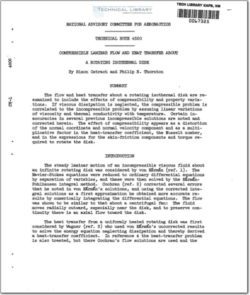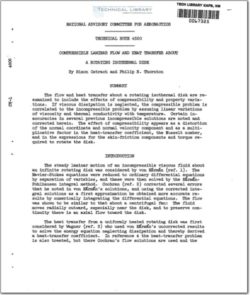NACA-TN-4320

- Version
- 172 Downloads
- 576.64 KB File Size
- 1 File Count
- December 4, 2015 Create Date
- December 4, 2015 Last Updated
National Advisory Committee for Aeronautics, Technical Notes - Compressible Laminar Flow and Heat Transfer About a Rotating Isothermal Disk

The flow and heat transfer about a rotating isothermal disk are re-
examined to include the effects of compressibility and property varia-
tions. If viscous dissipation is neglected, the compressible problem is
correlated to the incompressible problem by assuming linear variations
of viscosity and thermal conductivity with temperature. Certain in-
accuracies in several previous incompressible solutions are noted and
corrected herein. The effect of compressibility appears as a distortion
of the normal coordinate and normal velocity component and as a multi-
plicative factor in the heat-transfer coefficient, the Nusselt number,
and in the expressions for the skin—friction components and torque re—
quired to rotate the disk.
The steady laminar motion of an incompressible viscous fluid about
an infinite rotating disk was considered by von Karman (ref. 1). The
Navier-Stokes equations were reduced to ordinary differential equations
by separation of variables, and these were then solved by the Karman-
Pohlhausen integral method. Cochran (ref. 2) corrected several errors
that he noted in von Karman's solutions, and using the corrected inte-
gral solutions as a first approximation he obtained more accurate re-
sults by numerically integrating the differential equations. The flow
was shown to be similar to that about a centrifugal fan: The fluid
moves radially outward, especially near the disk, and to preserve con—
tinuity there is an axial flow toward the disk.
The heat transfer from a uniformly heated rotating disk was first
considered by wagner (ref. 5) who used von Karmén‘s uncorrected results
to solve the energy equation neglecting dissipation and thereby derived
a heat-transfer coefficient. In reference 4 the heat-transfer problem
is also treated, but there Cochran's flow solutions are used and the
energy equation including viscous dissipation is_solved. However, the
analyses (refs. 5 and 4) are restricted to apply to very small rotation
and very small temperature differences. For large rotations or heating
one might anticipate that the compressibility and property variations of
the fluid would be anortant. Therefbre, the problem is reexamined here-
in to include these effects.
| File | Action |
|---|---|
| naca-tn-4320.pdf | Download |

Comment On This Post